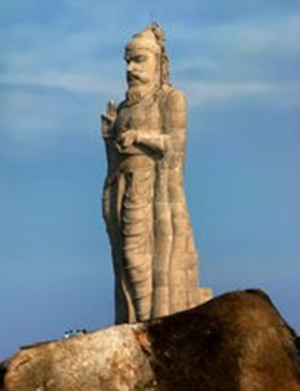Talk:Sant Tiruvaḷḷuvar (200 BCE)
By Vishal Agarwal
Another very ancient Indic language is Tamil. According to tradition, both Saṃskṛta (Sanskrit) and Tamil originated from Bhagavān Śiva through the two sides of his ḍamaru (cosmic drum). Scholars such as Pāṇini composed the grammar of Saṃskṛta, while sages like Agastya formulated the grammar of Tamil. For this reason, Tamil, like Sanskrit, is regarded by many as a sacred language of Hindu Dharm.
One of the most beautiful scriptures in Tamil is the Kural, composed by Sant Thiruvalluvar, who is believed to have been a weaver by profession. The Kural—also called the Tirukkural—contains over 1,300 couplets offering profound moral and philosophical guidance on how to live according to dharma. A magnificent statue of Thiruvalluvar now stands at Kanyākumārī, the southernmost tip of the Indian peninsula.
Very little is historically known about Thiruvalluvar, but traditional accounts describe him as a wise and humble man whose wife served him with great devotion and respect. Indeed, many popular stories about the couple highlight her exemplary character and virtue.
The following verses from the Kural beautifully express the importance of children in human life:
- The greatest blessing in life is to give birth to intelligent children.
- The real wealth of a person lies in their children; good karma from past lives grants one wise offspring.
- Far sweeter than divine nectar (amṛta) is simple rice stirred by the small hands of one’s child.
- The sounds made by one’s child are more delightful than music from any flute or lute.
- Parents are happiest when their children surpass them in virtue and wisdom. A mother rejoices at her child’s birth but feels even greater joy when others praise her grown child.
From the Kural of Thiruvalluvar
Tamil saints began composing spiritual and philosophical works more than 2,000 years ago. Some Tamil scriptures, such as the Tiruvāymoḻi, are revered by devotees as being as sacred as the Vedas themselves. As mentioned in earlier chapters, the Tamil language—like Sanskrit—is regarded as divine in origin.
Over the centuries, Hindu Dharm have created a vast body of literature not only in Saṃskṛta and Tamil but also in numerous other languages such as Hindi, Marathi, Telugu, Nepali, Bengali, Kannada, Javanese (from Indonesia), and Punjabi, reflecting the immense diversity and richness of India’s literary and spiritual heritage.

